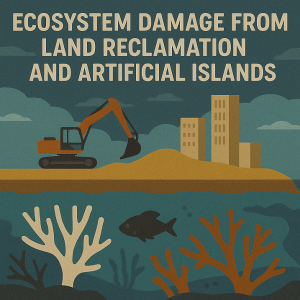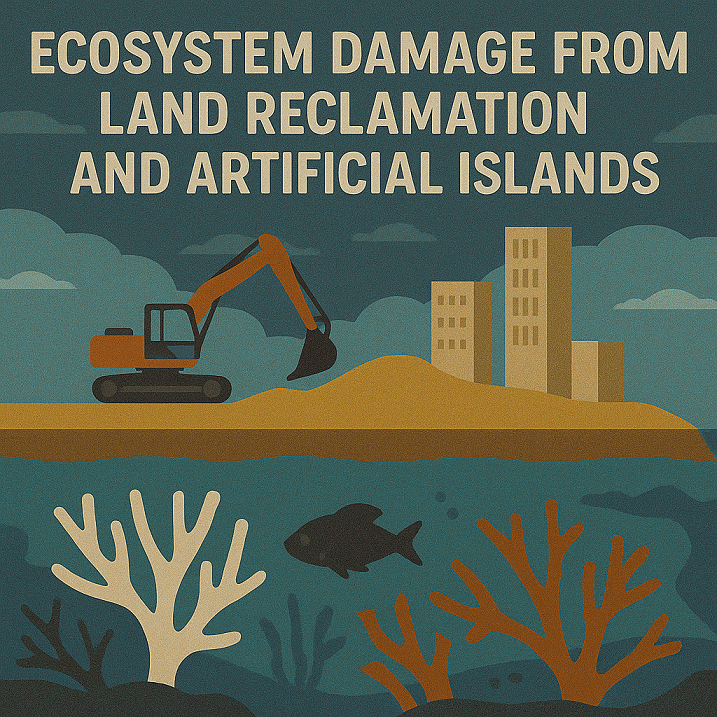Explore how land reclamation and artificial islands are affecting marine ecosystems worldwide. Learn about environmental impacts, real-world examples, regulatory responses, and future solutions in this detailed guide.

Why Ecosystem Damage from Land Reclamation Matters
Land reclamation is not new. From the Netherlands’ polders to Dubai’s Palm Islands, humans have reshaped coastlines to create land where there was none. In the 21st century, however, the scale and frequency of these interventions—especially through artificial islands—have raised major ecological alarms.
The practice involves dredging the seabed or transporting sediment to build up land in shallow coastal waters. While this provides economic benefits such as port development, tourism zones, or strategic military outposts, it also disrupts fragile marine ecosystems that have evolved over thousands of years. The United Nations Environment Programme (UNEP) has highlighted land reclamation as one of the leading causes of coastal habitat loss globally, especially in biodiverse zones like Southeast Asia and the Persian Gulf.
Marine ecosystems, once disturbed or removed, often take decades—or longer—to recover, if they recover at all. The implications are not just environmental but social, economic, and geopolitical.
Environmental Impacts of Land Reclamation and Artificial Islands
Destruction of Coral Reefs and Seagrasses
Coral reefs are among the first victims of dredging and reclamation. These complex ecosystems support thousands of marine species, many of which are commercially valuable. In the South China Sea, a 2020 study published in Marine Pollution Bulletin noted that up to 60% of coral coverage had been lost in areas of intense reclamation.
Seagrass meadows, often dismissed as simple underwater lawns, are equally important. They sequester carbon, filter pollutants, and provide critical nurseries for fish. Reclamation buries these meadows under meters of sediment, wiping out entire habitats.
Increased Sedimentation and Turbidity
Reclamation activities stir up large volumes of fine sediments. This increases turbidity—cloudiness of the water—which reduces light penetration and affects photosynthesis in aquatic plants. Over time, this disrupts food chains, causes gill damage in fish, and smothers filter-feeding organisms like bivalves.
Displacement of Marine Species
As land replaces sea, marine species are either forced to migrate or perish. Dugongs, dolphins, turtles, and migratory birds often lose critical foraging or nesting grounds. A case documented by the IUCN Red List showed that dugong populations in Southeast Asia have drastically declined in part due to seagrass loss from reclamation.
Alteration of Hydrodynamics
Artificial islands and new coastlines can drastically change tidal flows and wave patterns. These changes influence sediment transport, erosion rates, and salinity. This has a knock-on effect on estuaries, mangroves, and adjacent coastlines, often leading to further habitat degradation.
Key Drivers Behind Reclamation Projects
Port and Trade Expansion
With over 80% of global trade moving by sea (UNCTAD, 2023), many coastal nations see land reclamation as a fast-track strategy to expand port capacity. The Port of Singapore, Port Klang (Malaysia), and Colombo Port City (Sri Lanka) are all examples of reclamation-driven maritime growth. However, this growth comes with ecological trade-offs.
Military and Strategic Reasons
In geopolitically sensitive areas like the South China Sea, artificial islands have been used for strategic positioning. Satellite images analyzed by IHS Markit and Lloyd’s List Intelligence show military installations replacing natural reefs. These moves, while bolstering security claims, intensify ecological loss.
Urban and Tourism Development
Iconic projects like Dubai’s The World Islands or Maldives’ Hulhumalé aim to address housing needs or boost tourism. Yet, a 2019 study in Ocean Engineering cautioned that such developments risk long-term environmental costs, including rising maintenance and climate-related vulnerability.
Real-World Case Studies
The South China Sea: Strategic Growth, Environmental Loss
Perhaps the most documented case of large-scale island building, the South China Sea has seen rapid transformation since 2013. According to a 2022 report by Marine Policy, over 3,200 acres of coral reef have been dredged and filled. This has affected fish migration, led to local extinctions, and increased regional tensions. Proposals for a marine peace park have emerged but lack implementation.
Colombo Port City, Sri Lanka
Launched with Chinese investment, this $15 billion project aims to turn Colombo into a South Asian maritime hub. Built on reclaimed land, the city is projected to increase economic output but also sparked criticism. A 2021 environmental review noted the destruction of key fish breeding grounds and increased coastal erosion downstream.
The Netherlands: A Double-Edged Model
Unlike tropical examples, the Netherlands offers a nuanced case. Projects like Maasvlakte II show how land reclamation can incorporate eco-engineering principles. Through environmental impact assessments and artificial reefs, the Dutch have attempted to minimize harm. Nonetheless, biodiversity remains affected, particularly in the Wadden Sea.
Recent Technological and Regulatory Developments
Remote Sensing and Satellite Monitoring
Advancements in satellite technology allow real-time monitoring of land change. Tools like Sentinel-2, MODIS, and Global Fishing Watch enable researchers and policymakers to detect unauthorized reclamation or assess ecological impacts quickly.
Environmental Impact Assessments (EIAs)
Many countries have made EIAs mandatory for coastal engineering. While their quality varies, international standards developed by the IMO, World Bank, and UNEP provide frameworks for consistent evaluation. New tools also allow cumulative impact assessments, considering long-term and large-scale effects.
Nature-Based Solutions and Eco-Reclamation
In response to criticism, some governments are exploring “eco-reclamation.” These projects integrate mangroves, wetlands, or artificial reefs to support biodiversity. For example, Singapore’s Pulau Tekong reclamation now includes green buffers and sediment-retaining seagrass belts.
Global Maritime Governance and Legal Complexities
UNCLOS and Maritime Jurisdiction
The United Nations Convention on the Law of the Sea (UNCLOS) remains the foundational legal framework. However, the convention does not fully account for artificial islands’ impacts. While islands don’t grant exclusive economic zones (EEZs), states often claim broader maritime rights, blurring legal boundaries.
Regional Initiatives
Organizations like the Association of Southeast Asian Nations (ASEAN) and the Partnerships in Environmental Management for the Seas of East Asia (PEMSEA) promote cooperative marine spatial planning. However, political will and enforcement remain inconsistent.
IMO and the London Protocol
The International Maritime Organization (IMO), through the London Protocol, regulates ocean dumping, including dredged material from reclamation. Still, loopholes remain in international enforcement, especially in disputed waters.
Frequently Asked Questions (FAQs)
What are the environmental risks of land reclamation?
These include coral reef destruction, loss of seagrasses, sediment pollution, and changes to marine currents and ecosystems.
Can artificial islands be environmentally friendly?
Yes, if eco-engineering is prioritized. However, most projects today prioritize economics over ecology.
Is land reclamation legal under international law?
Yes, but it must comply with UNCLOS and avoid infringing on EEZs or damaging shared ecosystems.
How can we reduce ecosystem damage from reclamation?
Through rigorous EIAs, using sustainable dredging methods, implementing offset strategies, and involving marine scientists from the planning phase.
Which countries are most active in land reclamation?
China, the Netherlands, Singapore, UAE, and South Korea are among the top reclamation nations.
Do artificial islands contribute to climate change?
Indirectly. The carbon footprint of construction and habitat loss reduces natural carbon sinks like seagrasses and mangroves.
Are there successful examples of low-impact reclamation?
Yes. The Netherlands’ Maasvlakte II and Singapore’s Pulau Tekong projects show how environmental considerations can be built into design.
Conclusion: A Call for Balance
The construction of artificial islands and reclaimed lands is not inherently bad. It reflects human ingenuity and addresses real-world challenges like urban crowding and port expansion. Yet, unchecked reclamation damages marine ecosystems that are far more valuable in the long term.
If we aim to preserve the oceans not just for biodiversity but also for the prosperity of future generations, we must strike a balance—where development and ecology coexist.
Maritime professionals, students, and decision-makers must push for science-led planning, transboundary cooperation, and enforcement of global conventions. Only then can we navigate the blue frontier responsibly.
References
- UNCTAD Review of Maritime Transport 2023
- Marine Pollution Bulletin
- United Nations Environment Programme (UNEP)
- IMO London Protocol
- Marine Policy Journal
- Ocean Engineering Journal
- IUCN Red List
- Global Fishing Watch
- World Bank Environmental Guidelines
- UNCLOS
- PEMSEA
- Lloyd’s List Intelligence
- IHS Markit (now S&P Global)

